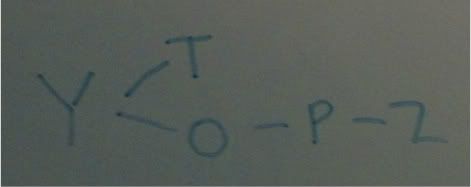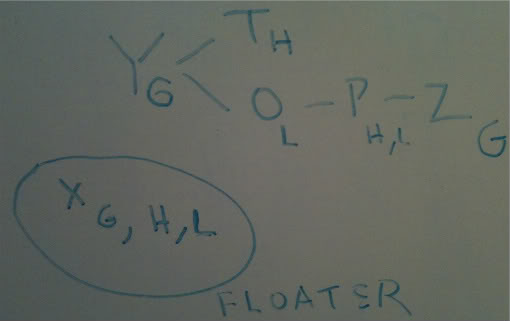This took me about 14 minutes to do and I did it by creating frames...very time consuming.
What diagram is the most efficient for this game?
Thanks in advance!
LSAT Forum
4 postsPage 1 of 1
-

- anniekim89
-
Thanks Received: 0
-
Vinny Gambini

- Posts: 7
- Joined: November 03rd, 2010
-

- timmydoeslsat
-
Thanks Received: 887
-
Atticus Finch

- Posts: 1136
- Joined: June 20th, 2011

- Most Thanked

- First Responder
Re: Diagram
First we will list the variables and groups for the game. (Ignore the check marks and random denotation for now!)

The first two rules of this game gives us a tree diagram that can be shown below.

I went back and placed a check above each variable that is accounted for in that tree diagram, and X is not listed. This means that X is a random, floater, free agent, etc. X has no rules governing where it goes. It can go 1-7 and not break any rules, because there are no rules governing it! The only thing you must keep track of is the last rule about the vocalist who goes first cannot go last.
Who can go first? Other than X, which is random, Y can would have to go first if X does not and vice versa. All of the other variables must follow Y, so they cannot be first.
The third, fourth, and fifth rules are full of huge deductions.
I decided to reorganize the information that was given. Instead of showing what each vocalist can have in terms of songs, I decided to show who can possible sing each song. You did not have to do it this way. Over the course of doing many logic games, you will develop an intuition of what will put time in the bank on games and what will not. I determined it would for me.

Notice that 4 of the 6 songs have only one vocalist that can possibly sing it!
I went back to my tree diagram and plugged it in that information.

Some other inferences you can think about are that if Y is first, Z cannot be last because of the 1-6 different vocalist rule.
Or something like if you have X first in a situation, you can give it any vocalist you want as long as it is different from the song that goes 6th so we do not violate the 1-6 rule.

The first two rules of this game gives us a tree diagram that can be shown below.

I went back and placed a check above each variable that is accounted for in that tree diagram, and X is not listed. This means that X is a random, floater, free agent, etc. X has no rules governing where it goes. It can go 1-7 and not break any rules, because there are no rules governing it! The only thing you must keep track of is the last rule about the vocalist who goes first cannot go last.
Who can go first? Other than X, which is random, Y can would have to go first if X does not and vice versa. All of the other variables must follow Y, so they cannot be first.
The third, fourth, and fifth rules are full of huge deductions.
I decided to reorganize the information that was given. Instead of showing what each vocalist can have in terms of songs, I decided to show who can possible sing each song. You did not have to do it this way. Over the course of doing many logic games, you will develop an intuition of what will put time in the bank on games and what will not. I determined it would for me.

Notice that 4 of the 6 songs have only one vocalist that can possibly sing it!
I went back to my tree diagram and plugged it in that information.

Some other inferences you can think about are that if Y is first, Z cannot be last because of the 1-6 different vocalist rule.
Or something like if you have X first in a situation, you can give it any vocalist you want as long as it is different from the song that goes 6th so we do not violate the 1-6 rule.
-

- ManhattanPrepLSAT1
-
Thanks Received: 1909
-
Atticus Finch

- Posts: 2851
- Joined: October 07th, 2009
Re: Diagram
Great work timmydoeslsat! I think that's a great approach you took there. in fact the point when you decided to
was brilliant!
Have you seen that in other games? It's in at least two others that I've worked on.
PT31, S1, G4
PT38, S2, G4
I've tried creating frames on this game, but never been satisfied that there's a nice elegant set that works well here. I'd set up a game board in the following way
_ _ _ _ _ _ O P T X Y Z
_ _ _ _ _ _ G G H H L L
1 2 3 4 5 6
plug in the constraints and hit the questions. See attached for a diagram with the constraints notated.
timmydoeslsat Wrote:I decided to reorganize the information that was given. Instead of showing what each vocalist can have in terms of songs, I decided to show who can possible sing each song. You did not have to do it this way. Over the course of doing many logic games, you will develop an intuition of what will put time in the bank on games and what will not. I determined it would for me.
was brilliant!
Have you seen that in other games? It's in at least two others that I've worked on.
PT31, S1, G4
PT38, S2, G4
anniekim89 Wrote:This took me about 14 minutes to do and I did it by creating frames...very time consuming.
What diagram is the most efficient for this game?
I've tried creating frames on this game, but never been satisfied that there's a nice elegant set that works well here. I'd set up a game board in the following way
_ _ _ _ _ _ O P T X Y Z
_ _ _ _ _ _ G G H H L L
1 2 3 4 5 6
plug in the constraints and hit the questions. See attached for a diagram with the constraints notated.
-

- mlbrandow
-
Thanks Received: 17
-
Jackie Chiles

- Posts: 29
- Joined: January 22nd, 2012
- This post thanked 1 time.
Re: Diagram
My time on this game was 3:40 (4:48 after fully double checking).
I really think the key here is, like you said, just to have a great initial diagram. For me, the key to a lot of these games is realizing that no singular approach is necessarily the best. By that I mean that using various approaches as tools rather than templates can serve you best on some games, and this is a great example.
Here's my diagram for this game, and this is the only information I wrote on the entire page (other than crossing out or circling answer choices):

In black is what I wrote down, and in red is what I visualized in my head.
Once I wrote down the possibilities for GHL as given, I noticed that in fact four of the six songs can only be played by one musician. So while my initial sequence chain had only the songs, I quickly added the known letters.
I also feel it's powerful to add any unrestricted variables to your chain, especially in this case where there is only one. Write it out next to the chain so you can see that it can go anywhere.
Another piece of advice I can offer is to check the acceptability question answer choices with regard to the most cumbersome rule first. The first thing I did when I was ready to attack the questions was look for a way 1-/-6 was violated, and being able to cross of answer choice C (a good trap answer) in about four seconds was extremely helpful in speeding through this game.
It's also worth noting that my initial completed time was 3:09, and I had just circled A on 24 because it passed sequence chain test. Only after going back over the other possible answer choices did I notice that C could also be true, which meant one of them was false, and in fact A breaks the 1-/-6 rule, another great trap answer choice.
Lastly, I highly recommend stacking variables in linear games whenever you can do that conceptually, as I did here. If you can clump them together without having to draw a big cumbersome diagram, it will allow for easier reproduction on hypothetical questions. In this game, I didn't need to draw anything other than my initial setup, but other games are not so accommodating.
Good luck!
I really think the key here is, like you said, just to have a great initial diagram. For me, the key to a lot of these games is realizing that no singular approach is necessarily the best. By that I mean that using various approaches as tools rather than templates can serve you best on some games, and this is a great example.
Here's my diagram for this game, and this is the only information I wrote on the entire page (other than crossing out or circling answer choices):

In black is what I wrote down, and in red is what I visualized in my head.
Once I wrote down the possibilities for GHL as given, I noticed that in fact four of the six songs can only be played by one musician. So while my initial sequence chain had only the songs, I quickly added the known letters.
I also feel it's powerful to add any unrestricted variables to your chain, especially in this case where there is only one. Write it out next to the chain so you can see that it can go anywhere.
Another piece of advice I can offer is to check the acceptability question answer choices with regard to the most cumbersome rule first. The first thing I did when I was ready to attack the questions was look for a way 1-/-6 was violated, and being able to cross of answer choice C (a good trap answer) in about four seconds was extremely helpful in speeding through this game.
It's also worth noting that my initial completed time was 3:09, and I had just circled A on 24 because it passed sequence chain test. Only after going back over the other possible answer choices did I notice that C could also be true, which meant one of them was false, and in fact A breaks the 1-/-6 rule, another great trap answer choice.
Lastly, I highly recommend stacking variables in linear games whenever you can do that conceptually, as I did here. If you can clump them together without having to draw a big cumbersome diagram, it will allow for easier reproduction on hypothetical questions. In this game, I didn't need to draw anything other than my initial setup, but other games are not so accommodating.
Good luck!
4 posts Page 1 of 1